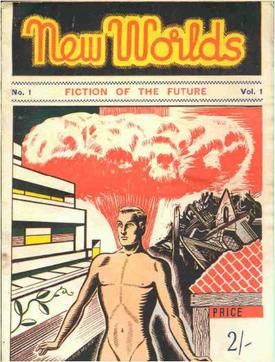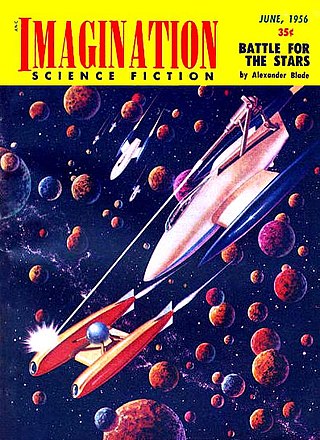An ansible is a category of fictional devices or technology capable of near-instantaneous or faster-than-light communication. It can send and receive messages to and from a corresponding device over any distance or obstacle whatsoever with no delay, even between star systems. As a name for such a device, the word "ansible" first appeared in a 1966 novel by Ursula K. Le Guin. Since that time, the term has been broadly used in the works of numerous science fiction authors, across a variety of settings and continuities. A related term is ultrawave.

Brian Wilson Aldiss was an English writer, artist and anthology editor, best known for science fiction novels and short stories. His byline reads either Brian W. Aldiss or simply Brian Aldiss, except for occasional pseudonyms during the mid-1960s.
The New Wave was a science fiction style of the 1960s and 1970s, characterized by a great degree of experimentation with the form and content of stories, greater imitation of the styles of non-science fiction literature, and an emphasis on the psychological and social sciences as opposed to the physical sciences. New Wave authors often considered themselves as part of the modernist tradition of fiction, and the New Wave was conceived as a deliberate change from the traditions of the science fiction characteristic of pulp magazines, which many of the writers involved considered irrelevant or unambitious.
A future history is a fictional history of the future used by authors of science fiction and other speculative fiction to construct a common background for stories. Sometimes the author publishes a timeline of events in the history, while other times the reader can reconstruct the order of the stories from information provided. The term can also be used to describe the subgenre of science fiction that uses this framework.

Robert Shaw was a science fiction writer and fan from Northern Ireland, noted for his originality and wit. He won the Hugo Award for Best Fan Writer in 1979 and 1980. His short story "Light of Other Days" was a Hugo Award nominee in 1967, as was his novel The Ragged Astronauts in 1987.
Galactic empires are a science fiction setting trope, in which most or all of the habitable planets in the setting's galaxy are ruled by a single centralized political entity. Galactic empires most frequently appear in works in the sub-genres of science fantasy and space opera, although they may appear in other sub-genres as well. Works featuring galactic empires may have them as the story's focus, chronicling the empire's growth and/or decline. Alternatively, they may merely serve as a backdrop against which the events of the story play out.

Dangerous Visions is an anthology of science fiction short stories edited by American writer Harlan Ellison and illustrated by Leo and Diane Dillon. It was published in 1967 and contained 33 stories, none of which had been previously published.

David Rowland Langford is a British author, editor, and critic, largely active within the science fiction field. He publishes the science-fiction fanzine and newsletter Ansible and holds the all-time record for most Hugo Awards, with a total of 29 wins.

Interzone is a British fantasy and science fiction magazine. Published since 1982, Interzone is the eighth-longest-running English language science fiction magazine in history, and the longest-running British science fiction (SF) magazine. Stories published in Interzone have been finalists for the Hugo Awards and have won a Nebula Award and numerous British Science Fiction Awards.

Science Fantasy, which also appeared under the titles Impulse and SF Impulse, was a British fantasy and science fiction magazine, launched in 1950 by Nova Publications as a companion to Nova's New Worlds. Walter Gillings was editor for the first two issues, and was then replaced by John Carnell, the editor of New Worlds, as a cost-saving measure. Carnell edited both magazines until Nova went out of business in early 1964. The titles were acquired by Roberts & Vinter, who hired Kyril Bonfiglioli to edit Science Fantasy; Bonfiglioli changed the title to Impulse in early 1966, but the new title led to confusion with the distributors and sales fell, though the magazine remained profitable. The title was changed again to SF Impulse for the last few issues. Science Fantasy ceased publication the following year, when Roberts & Vinter came under financial pressure after their printer went bankrupt.

New Worlds was a British science fiction magazine that began in 1936 as a fanzine called Novae Terrae. John Carnell, who became Novae Terrae's editor in 1939, renamed it New Worlds that year. He was instrumental in turning it into a professional publication in 1946 and was the first editor of the new incarnation. It became the leading UK science fiction magazine; the period to 1960 has been described by science fiction historian Mike Ashley as the magazine's "Golden Age".
In science fiction, uplift is a developmental process to transform a certain species of animals into more intelligent beings by other, already-intelligent beings. This is usually accomplished by cultural, technological, or evolutional interventions like genetic engineering. The earliest appearance of the concept is in H. G. Wells's 1896 novel The Island of Doctor Moreau. The term was popularized by David Brin in his Uplift series in the 1980s.

Mythago Wood is a fantasy novel by British writer Robert Holdstock, published in the United Kingdom in 1984. Mythago Wood is set in Herefordshire, England, in and around a stand of ancient woodland, known as Ryhope Wood. The story involves the internally estranged members of the Huxley family, particularly Stephen Huxley, and his experiences with the enigmatic forest and its magical inhabitants. The conception began as a short story written for the 1979 Milford Writer's Workshop; a novella of the same name appeared in the September 1981 edition of The Magazine of Fantasy & Science Fiction.

The Flying Sorcerers is a humorous 1971 science fiction novel by American writers David Gerrold and Larry Niven. It was originally serialized in 1970 as The Misspelled Magishun in If magazine.
The 45th World Science Fiction Convention (Worldcon), also known as Conspiracy '87, was held on 27 August–1 September 1987 at the Metropole Hotel and The Brighton Centre in Brighton, United Kingdom.

Science Fiction Monthly was a British science fiction magazine published from 1974 to 1976 by New English Library. Launched in response to demand from readers for posters of the cover art of New English Library's science fiction paperbacks, it was initially very successful—its circulation had reached 150,000 by the third issue. It reprinted artwork by Chris Foss, Jim Burns, Bruce Pennington, Roger Dean, and many others. Well-known writers who appeared in its pages included Brian Aldiss, Bob Shaw, Christopher Priest, and Harlan Ellison. High production costs meant that a large circulation was necessary to sustain profitability, and when circulation fell to about 20,000 after two years NEL ceased publication. A new magazine, S.F. Digest, was launched in its stead but lasted only one issue.

Steve Green is a former newspaper reporter (1978–84) turned freelance journalist, who has also written short fiction and poetry. He is an active member of the science fiction press and fan community.

Space opera is a subgenre of science fiction that emphasizes space warfare, with use of melodramatic, risk-taking space adventures, relationships, and chivalric romance. Set mainly or entirely in outer space, it features technological and social advancements in faster-than-light travel, futuristic weapons, and sophisticated technology, on a backdrop of galactic empires and interstellar wars with fictional aliens, often in fictional galaxies. The term does not refer to opera music, but instead originally referred to the melodrama, scope, and formulaicness of operas, much as used in "horse opera", a 1930s phrase for a clichéd and formulaic Western film, and "soap opera", a melodramatic television series. Space operas emerged in the 1930s and continue to be produced in literature, film, comics, television, video games and board games.
Inner space in the context of science fiction refers to works of psychological science fiction focusing on the internal, mental experiences. Works from this genre appeared as part of the emergence of the New Wave in science fiction in the 1960s.











